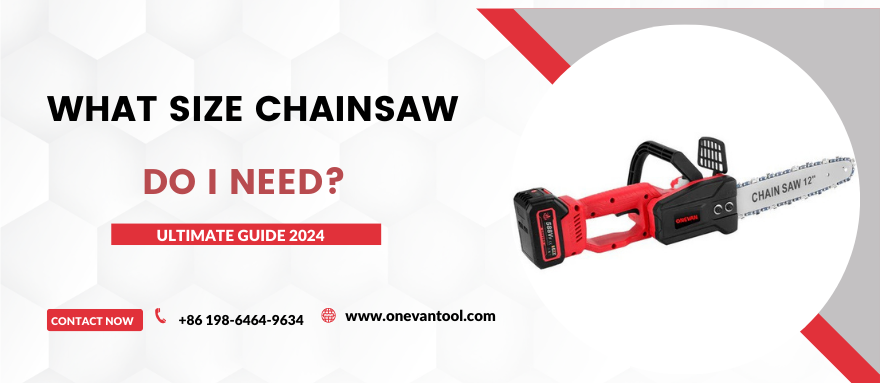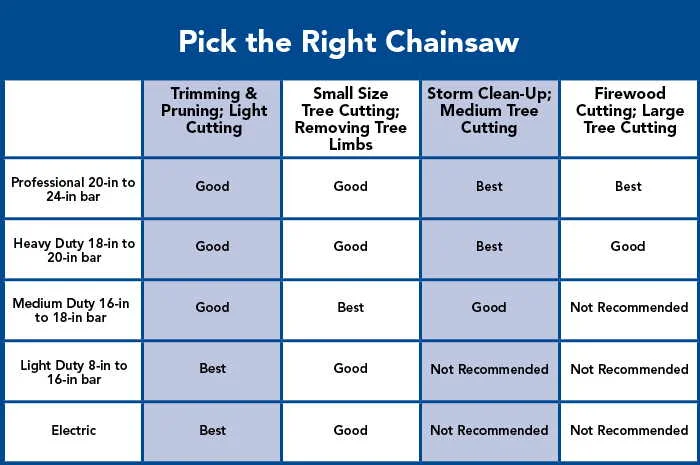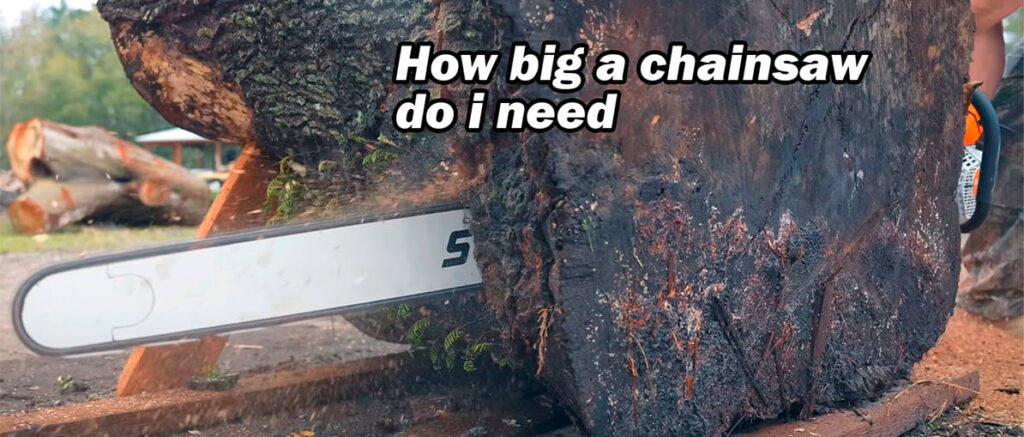Deciding on the right chainsaw size can be challenging. It depends on your tasks.
Are you cutting firewood or trimming branches? Knowing the right size chainsaw is crucial for safety and efficiency. A chainsaw too big or too small can make your job harder. This guide will help you choose the perfect size for your needs.
We’ll look at the tasks you plan to do and match them to the right chainsaw size. Keep reading to learn what you need to know before making a purchase. The right choice will make your work easier and safer. Let’s find the perfect chainsaw for you.
Choosing The Right Chainsaw Size
Finding the right chainsaw size is crucial. It ensures your safety and efficiency. With many options available, knowing the right size helps. A chainsaw that’s too big or small can cause issues. Let’s explore the factors to consider when choosing the right chainsaw size.
Factors To Consider
First, think about the type of work you will do. For light pruning, a smaller chainsaw is best. For cutting large trees, a bigger saw is needed. Next, consider your experience. Beginners may handle smaller chainsaws better. Experienced users can manage larger ones safely.
Also, consider the material you will cut. Softwoods need less power compared to hardwoods. The weight of the chainsaw matters too. Heavier chainsaws can cause fatigue faster. Lastly, think about storage and transportation. Bigger chainsaws need more space.
Common Sizes And Uses
Chainsaws come in various sizes. The most common sizes range from 12 to 24 inches. A 12 to 14-inch chainsaw is ideal for light tasks. These include pruning and small branch cutting.
For medium tasks, a 16 to 18-inch chainsaw works well. These can handle cutting small trees and firewood. Larger tasks need a 20 to 24-inch chainsaw. These are perfect for felling large trees and heavy-duty cutting.
Choosing the right size ensures efficiency and safety. Always match the chainsaw size to your task and experience level.

Credit: onevantool.com
Assessing Your Project Needs
Choosing the right chainsaw size is crucial for effective and safe cutting. It’s not just about power; the size of the chainsaw should match the demands of your project. Assess your project needs carefully before making a decision.
Types Of Projects
Different projects require different chainsaw sizes. Here are some common projects and the recommended chainsaw sizes:
- Light Pruning: Small electric chainsaws (10-12 inches) are ideal.
- Trimming Branches: Medium chainsaws (14-16 inches) work well.
- Cutting Firewood: Use larger chainsaws (16-20 inches).
- Felling Trees: Heavy-duty chainsaws (20 inches or more) are needed.
Frequency Of Use
Consider how often you will use the chainsaw:
- Occasional Use: A small or medium chainsaw is sufficient.
- Regular Use: Opt for a medium to large chainsaw for durability.
- Professional Use: Invest in a heavy-duty chainsaw for long-term efficiency.
Matching the chainsaw size with your project and usage frequency ensures efficiency and safety.
Chainsaw Bar Length Guide
Choosing the right chainsaw bar length is crucial for your tasks. The length affects performance, safety, and efficiency. This guide will help you understand the different bar sizes and their uses.
Small Bars
Small bars are typically 10 to 14 inches long. They’re ideal for light tasks. Pruning, limbing, and small tree cutting are perfect for these bars. They are easy to handle and control. Beginners often start with small bars. They are also good for occasional use. Small bars are lightweight. This reduces fatigue during work.
Medium Bars
Medium bars range from 16 to 20 inches. They are versatile and common. Suitable for cutting firewood, moderate tree felling, and larger branches. Medium bars offer a balance. They are not too heavy or too light. Professionals and experienced users prefer these bars. They handle more demanding tasks with ease.
Large Bars
Large bars are over 20 inches long. These are for heavy-duty tasks. Cutting large trees and thick logs require large bars. They are powerful but harder to control. Only experienced users should handle them. Large bars can be tiring to use. They are best for professional loggers and foresters. Safety is crucial with large bars. Always wear protective gear.
Power And Performance
Choosing the right chainsaw is crucial. You need one that fits your tasks. Let’s explore the key aspects of power and performance.
Engine Power
Engine power is essential for a chainsaw’s performance. Measured in cubic centimeters (cc) for gas and amperes (A) for electric. Higher values mean more power. More power allows you to cut thicker, tougher wood.
For small tasks, a 30cc to 40cc engine is enough. Medium tasks need 40cc to 50cc. Heavy tasks, like felling large trees, require 50cc and above.
Here’s a quick reference table:
| Task | Recommended Engine Power |
|---|---|
| Light Pruning | 30cc to 40cc |
| Medium Cutting | 40cc to 50cc |
| Heavy-Duty | 50cc and above |
Electric Vs Gas
Choosing between electric and gas chainsaws depends on your needs. Both have their pros and cons.
Electric Chainsaws:
- Lightweight and easy to handle.
- Less noise and no emissions.
- Perfect for small tasks and indoor use.
- Limited by power cord length or battery life.
Gas Chainsaws:
- More powerful and suitable for heavy-duty tasks.
- Can run for longer periods without recharging.
- More portable, no cords to limit movement.
- Heavier and noisier with emissions.
Consider your specific needs. For light, occasional use, electric might be ideal. For frequent, heavy-duty work, gas is better.
Handling And Maneuverability
Choosing the right chainsaw size involves considering handling and maneuverability. A chainsaw must be comfortable and easy to control. This makes your work safer and more efficient.
Weight Considerations
Weight is a crucial factor. A heavier chainsaw can cause fatigue quickly, reducing your work time. Here are some key points:
- Lightweight chainsaws are easier to handle for extended periods.
- Heavy chainsaws are harder to control and can be tiring.
- Balance is important; a well-balanced chainsaw feels lighter.
Check the weight before purchasing. Even a few pounds can make a big difference.
Ease Of Use
Ease of use goes hand in hand with weight. A chainsaw should be easy to start, operate, and maintain. Here are some features to consider:
- Automatic oiling systems keep the chain lubricated without effort.
- Ergonomic handles reduce strain and improve grip.
- Anti-vibration systems reduce fatigue and increase comfort.
These features can make a significant difference, especially for beginners. A chainsaw that is easy to use ensures a safer working environment.

Credit: autojaretool.com
Safety Considerations
Using a chainsaw can be dangerous if you do not follow safety guidelines. To ensure your safety and that of others, it is crucial to consider several safety aspects. This section covers the essential safety considerations you need to keep in mind.
Protective Gear
Wearing proper protective gear is a must while using a chainsaw. Here is a list of essential items you should wear:
- Helmet: Protects your head from falling branches.
- Safety glasses: Shields your eyes from wood chips.
- Ear protection: Guards against the loud noise of the chainsaw.
- Gloves: Provides a better grip and protects your hands.
- Chainsaw chaps or pants: Protects your legs from accidental cuts.
- Steel-toed boots: Offers foot protection and stability.
Safe Operating Practices
Following safe operating practices is key to preventing accidents. Here are some important tips:
- Read the manual: Understand your chainsaw’s specific features and safety mechanisms.
- Check the chainsaw: Inspect it for any damage before each use.
- Maintain a firm grip: Use both hands to hold the chainsaw securely.
- Clear the area: Ensure the work area is free of obstacles and bystanders.
- Stand correctly: Position your feet for balance and stability.
- Cut at waist level: Avoid cutting above shoulder height.
- Keep the chain sharp: A dull chain increases the risk of kickback.
- Stay alert: Always be aware of your surroundings and potential hazards.
By following these safety considerations, you can significantly reduce the risk of injury while using a chainsaw. Always prioritize safety to ensure a smooth and successful cutting experience.
Maintenance And Longevity
Proper maintenance is crucial for the longevity of your chainsaw. A well-maintained chainsaw performs better and lasts longer. Neglecting maintenance can lead to costly repairs and a shorter lifespan.
Routine Maintenance
Regular cleaning is essential. Remove debris from the chain and bar. Check the air filter and clean it frequently. Ensure the chain is sharp and well-lubricated. Replace the spark plug annually for optimal performance. Inspect the chain tension and adjust as needed.
Common Issues And Fixes
Chainsaw won’t start? Check the fuel mix. Old fuel can cause issues. If the chain is not cutting well, it might be dull. Sharpen it or replace it if necessary. If the chainsaw overheats, check the air filter and cooling fins. Clean them to ensure proper airflow.
Expert Recommendations
Choosing the right chainsaw size depends on your tasks. For small jobs, a 12-14 inch bar works well. Larger projects may need a 16-20 inch bar.
Choosing the right chainsaw can be challenging. Experts can guide you to the best choice. They consider factors such as power, size, and brand.Top Brands
Experts suggest several top chainsaw brands. Stihl is renowned for its reliability. Husqvarna is known for its power and durability. Echo offers great value for money. Each brand has models suitable for different needs.User Reviews
User reviews are valuable. They provide real-world insights. Many users praise Stihl for its consistent performance. Husqvarna users often highlight its robust build. Echo receives positive feedback for affordability. Reading reviews can help you decide. “`
Credit: www.youtube.com
Frequently Asked Questions
What Size Chainsaw Is Best For Home Use?
For home use, a chainsaw with a bar length of 14 to 16 inches is ideal. It’s versatile enough for most yard tasks, including cutting firewood and trimming trees.
Can A Small Chainsaw Cut Large Trees?
A small chainsaw can handle small to medium trees. For large trees, a larger chainsaw, typically with a bar length over 18 inches, is recommended.
How Do I Choose A Chainsaw Size?
Choose a chainsaw size based on your cutting needs. For light tasks, 14-16 inches is sufficient. For heavy-duty tasks, opt for 18 inches or more.
Is A Heavier Chainsaw Better?
Not necessarily. A heavier chainsaw provides more power but can be harder to control. Match the chainsaw weight to your strength and the task at hand.
Conclusion
Choosing the right chainsaw size is crucial. Think about your needs first. For light tasks, a smaller saw works well. Heavier jobs need a larger saw. Always consider your comfort and safety. A properly sized chainsaw makes work easier. It also helps you stay safe.
Research and compare options before buying. Talk to experts if unsure. This ensures you get the best tool for your tasks.
